Isocyanates Market SIze
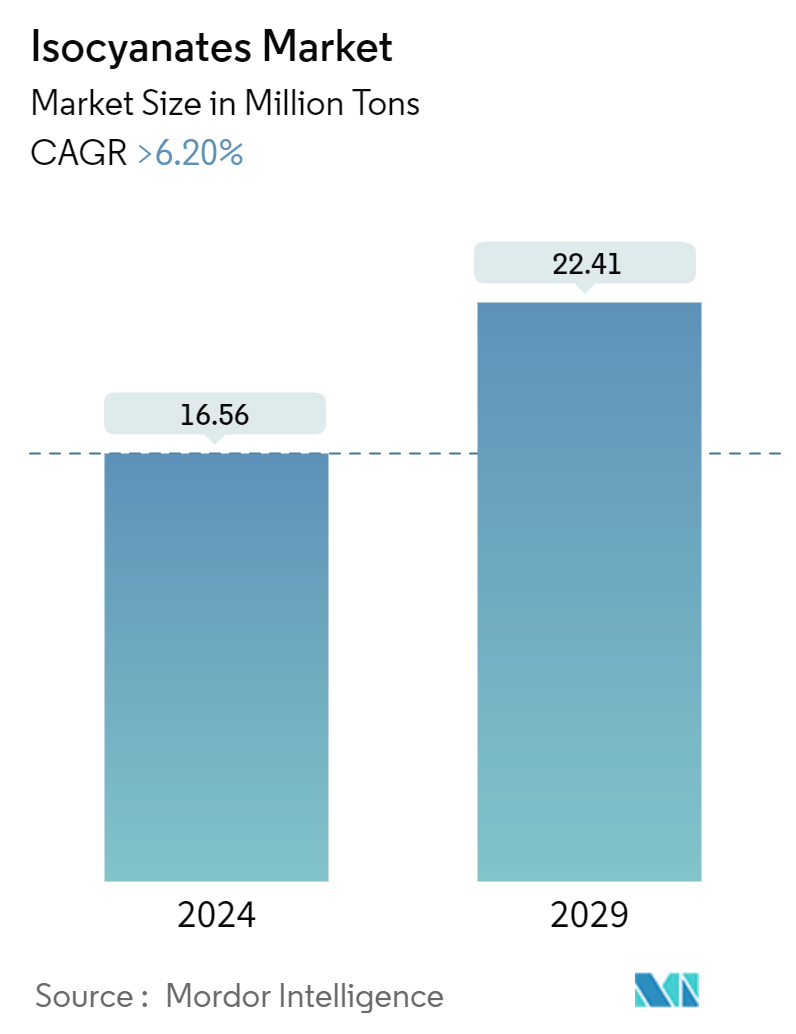
| Study Period | 2019 - 2029 |
| Base Year For Estimation | 2023 |
| CAGR (2024 - 2029) | 6.20 % |
| Fastest Growing Market | Asia Pacific |
| Largest Market | Asia Pacific |
| Market Concentration | Low |
Major Players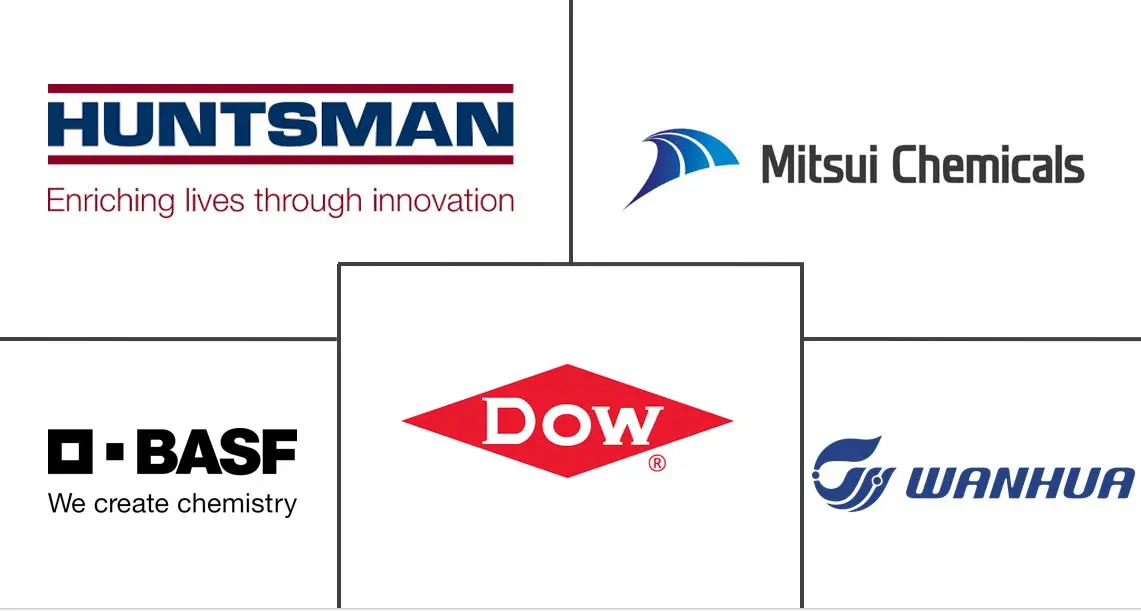
*Disclaimer: Major Players sorted in no particular order |
Isocyanates Market Analysis
The Isocyanates Market size is estimated at 16.56 Million tons in 2024, and is expected to reach 22.41 Million tons by 2029, growing at a CAGR of greater than 6.20% during the forecast period (2024-2029).
- Over the medium term, factors like growing applications of polyurethane foam, growing industrialization in Asia-Pacific, and growing demand from the construction industry are propelling the demand in the market studied.
- However, shortages and increased prices of raw materials are likely to restrain the market's growth.
- Growing investments by manufacturers in R&D activities and the high efficiency of bio-based isocyanates are expected to create opportunities for market growth in the future.
- Due to increased industrialization, Asia-Pacific dominated the isocyanates market, which is likely to witness a high growth rate during the forecast period.
Isocyanates Market Trends
Growing Automotive Production Post-Pandemic is Propelling the Market
- Isocyanates play a pivotal role in automotive coatings. These chemicals serve as key components in hardeners, particularly in topcoats and clearcoats. Furthermore, isocyanates are integral to producing automotive interiors and are utilized in flexible and integral foam systems found in seats, steering wheels, and carpets.
- According to the Organisation Internationale des Constructeurs d'Automobiles (OICA), global automotive production surged from 84.83 million units in 2022 to 93.54 million units in 2023, marking a 17% annual increase.
- Light vehicle production in North America showcased a Y-o-Y rise of 9.5% in 2023, reaching nearly 1.4 million units, as reported by OICA. With over 1 million units rolling out from the United States alone, the region stands out as a pivotal market for isocyanate-based products in the automotive sector.
- Furthermore, Asia-Pacific boasts some of the world’s most esteemed vehicle manufacturers. Nations like China, India, Japan, and South Korea are bolstering their manufacturing foundations and refining supply chains for enhanced profitability. OICA reported that in 2023, Asia-Pacific produced approximately 51.8 million light vehicles, marking a 10% growth rate and signaling heightened demand for isocyanate-based products in the automotive realm.
- The automotive sector is increasingly pivoting toward electric vehicles (EVs), underscored by substantial investments from leading automakers. According to the Natural Resources Defense Council (NRDC), in 2023, companies committed a staggering USD 210 billion to the EV sector, a leap from just over USD 50 billion at the onset of President Biden's term in 2021. This trajectory opened avenues for isocyanate applications in EV production, notably in adhesives and coatings.
- Hence, for the reasons above, the demand from the automotive sector is expected to witness positive growth during the forecast period.
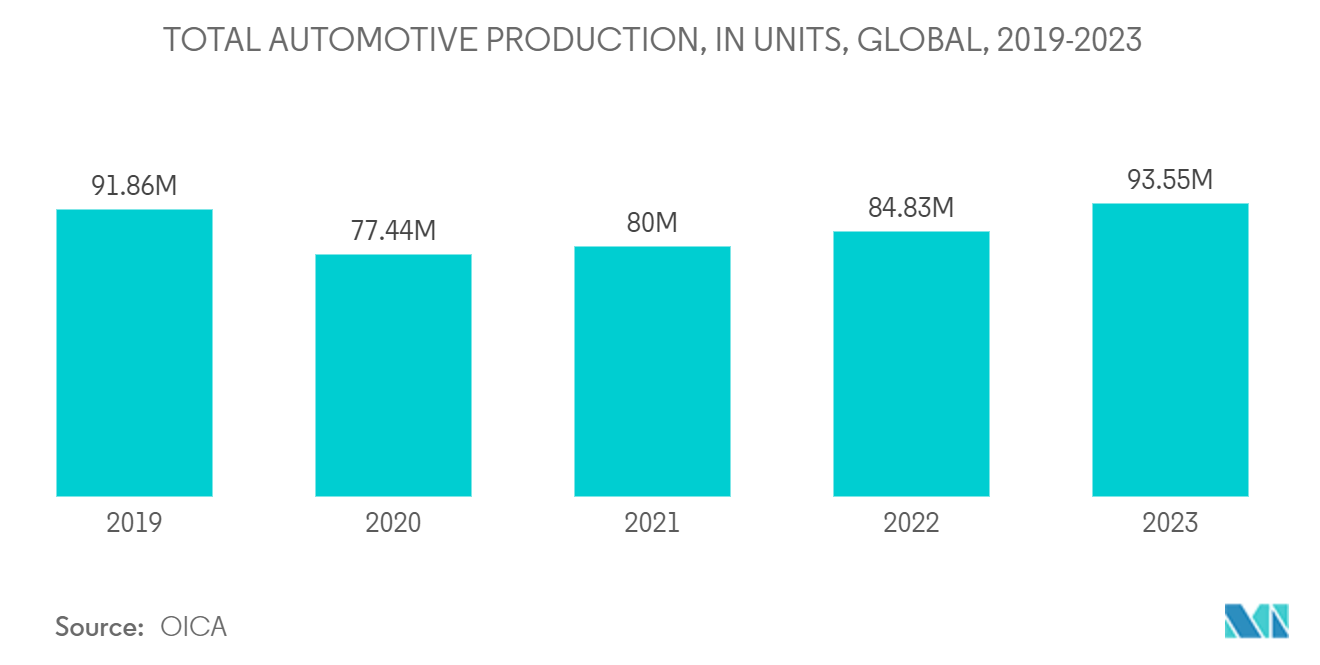
Asia-Pacific to Dominate the Market
- China emerges as the dominant global producer and consumer of polyurethane products in Asia-Pacific. In the Chinese market, MDI, a key ingredient for polyurethanes, is crucial for producing rigid and flexible foams.
- Data from Urethanes Technology International highlights China's dominance in the region. Polyurethane production increased 0.7% to 9.7 million tons in 2023.
- In India, MDI's primary application, polyurethane, is experiencing a surge in a wide array of applications, including adhesives and sealants, foams, paints, and coatings. This boom is fueled by a burgeoning middle class, rising disposable incomes, urbanization, and significant infrastructure investments.
- India's construction sector is poised to become the world's third-largest. Government initiatives, including the Smart Cities and Housing for All projects, are set to bolster the industry. Furthermore, energy efficiency regulations in India target areas like lighting, HVAC systems, and insulation, promoting sustainable practices in commercial buildings.
- Japan is witnessing a surge in polyurethane production, driven by growing demand from the construction, automotive, and furniture sectors, signaling a positive outlook for isocyanate market growth.
- Japan's automotive sector, a global frontrunner, saw a notable 16.1% annual growth in motor vehicle production in 2023, with figures reaching 8,572,848 units, as reported by the Japan Automotive Manufacturers Association (JAMA).
- Hence, Asia-Pacific is likely to dominate the market during the forecast period.
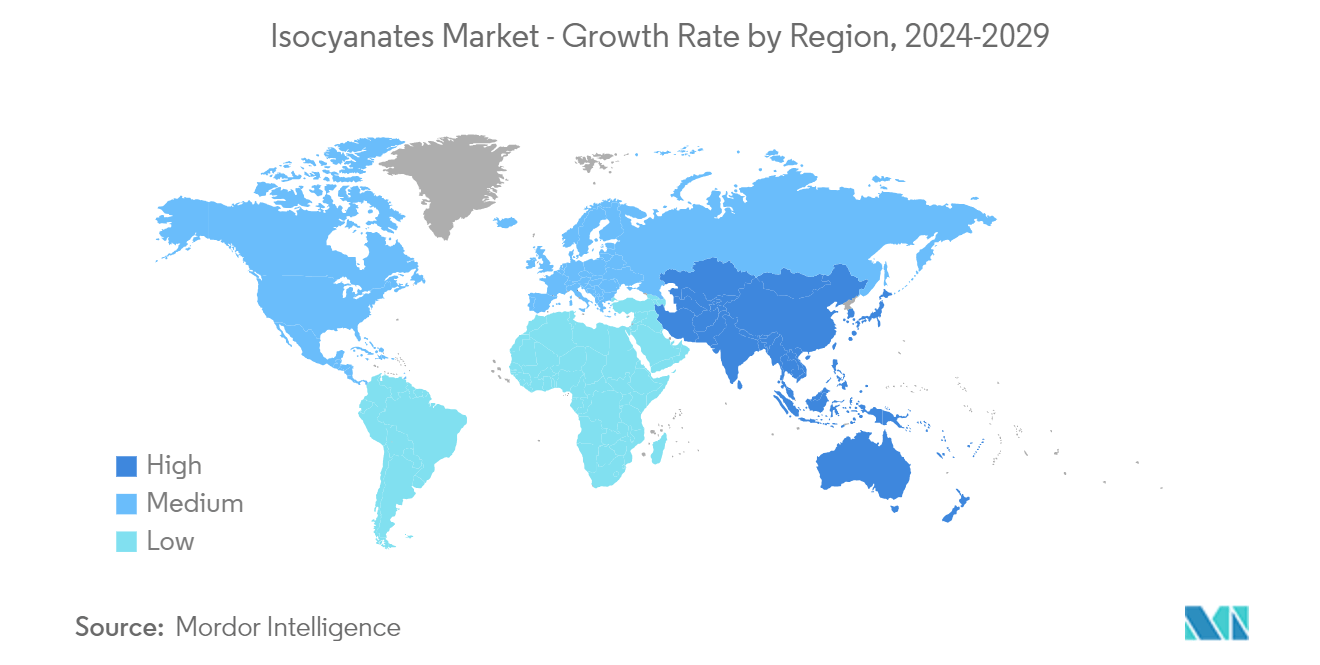
Isocyanates Industry Overview
The isocyanate market is partly consolidated as the global market share is divided among a few companies. Some of the key players in the market include Dow, BASF SE, Wanhua Chemical Group Co. Ltd, Huntsman Corporation LLC, and Mitsui Chemicals Inc. (not in any particular order).
Isocyanates Market Leaders
-
BASF SE
-
Mitsui Chemicals, Inc.
-
Wanhua Chemical Group Co., Ltd
-
Huntsman Corporation LLC
-
Dow
*Disclaimer: Major Players sorted in no particular order
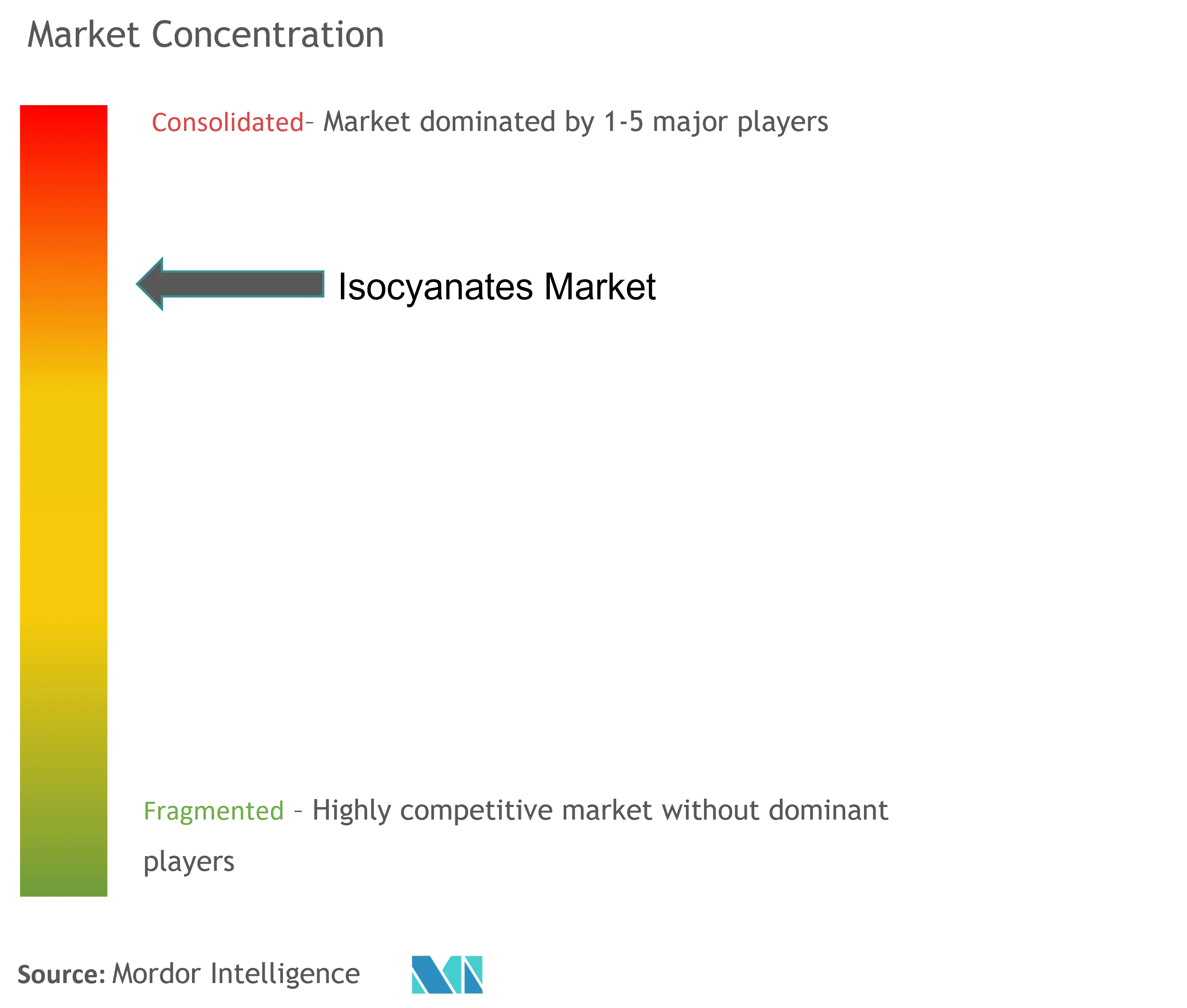
Isocyanates Market News
- February 2024: In response to the rising demand for hardeners in coatings, Mitsui Chemicals Inc. announced the expansion of its production capacity at its meta-xylylene diisocyanate (XDI) plant located in Omuta Works.
- January 2023: BASF commenced the third and final phase of its methylene diphenyl diisocyanate (MDI) expansion project at the Verbund site in Geismar, Louisiana. By 2025, the company aims to boost its production capacity to around 600,000 metric tons annually, catering to the rising demands of its North American MDI clientele.
Isocyanates Market Report - Table of Contents
1. INTRODUCTION
- 1.1 Study Assumptions
- 1.2 Scope of the Study
2. RESEARCH METHODOLOGY
3. EXECUTIVE SUMMARY
4. MARKET DYNAMICS
-
4.1 Drivers
- 4.1.1 Huge Growth in the Polyurethane Foam Application
- 4.1.2 Increase in Industrialization Activities in Asia-Pacific
- 4.1.3 Increasing Demand from the Construction Industry
-
4.2 Restraints
- 4.2.1 Shortage and Increased Price of Raw Material
- 4.2.2 Hazardous in Nature
- 4.3 Industry Value-Chain Analysis
-
4.4 Porter's Five Forces Analysis
- 4.4.1 Bargaining Power of Suppliers
- 4.4.2 Bargaining Power of Consumers
- 4.4.3 Threat of New Entrants
- 4.4.4 Threat of Substitute Products and Services
- 4.4.5 Degree of Competition
- 4.5 Price Trend
- 4.6 Regulatory Policy Analysis
5. MARKET SEGMENTATION (Market Size in Volume)
-
5.1 By Type
- 5.1.1 MDI
- 5.1.2 TDI
- 5.1.3 Aliphatic
- 5.1.4 Other Types
-
5.2 By Application
- 5.2.1 Rigid Foam
- 5.2.2 Flexible Foam
- 5.2.3 Paints & Coatings
- 5.2.4 Adhesives & Sealants
- 5.2.5 Elastomers
- 5.2.6 Binders
- 5.2.7 Other Applications
-
5.3 By End-user Industry
- 5.3.1 Building and Construction
- 5.3.2 Automotive
- 5.3.3 Healthcare
- 5.3.4 Furniture
- 5.3.5 Other End-user Industries (Aerospace, Electronics, Water Vessels, etc.)
-
5.4 By Geography
- 5.4.1 Asia-Pacific
- 5.4.1.1 China
- 5.4.1.2 India
- 5.4.1.3 Japan
- 5.4.1.4 South Korea
- 5.4.1.5 Malaysia
- 5.4.1.6 Thailand
- 5.4.1.7 Indonesia
- 5.4.1.8 Vietnam
- 5.4.1.9 Rest of Asia-Pacific
- 5.4.2 North America
- 5.4.2.1 United States
- 5.4.2.2 Canada
- 5.4.2.3 Mexico
- 5.4.3 Europe
- 5.4.3.1 Germany
- 5.4.3.2 United Kingdom
- 5.4.3.3 Italy
- 5.4.3.4 France
- 5.4.3.5 Russia
- 5.4.3.6 Spain
- 5.4.3.7 Turkey
- 5.4.3.8 Nordic Countries
- 5.4.3.9 Rest of Europe
- 5.4.4 South America
- 5.4.4.1 Brazil
- 5.4.4.2 Argentina
- 5.4.4.3 Colombia
- 5.4.4.4 Rest of South America
- 5.4.5 Middle East and Africa
- 5.4.5.1 Saudi Arabia
- 5.4.5.2 United Arab Emirates
- 5.4.5.3 Qatar
- 5.4.5.4 Egypt
- 5.4.5.5 Nigeria
- 5.4.5.6 South Africa
- 5.4.5.7 Rest of Middle East and Africa
6. COMPETITIVE LANDSCAPE
- 6.1 Mergers & Acquisitions, Joint Ventures, Collaborations, and Agreements
- 6.2 Market Share**/Ranking Analysis
- 6.3 Strategies Adopted by Leading Players
-
6.4 Company Profiles
- 6.4.1 Anderson Development Company
- 6.4.2 Asahi Kasei Chemicals
- 6.4.3 BASF SE
- 6.4.4 BorsodChem
- 6.4.5 China National Bluestar (Group) Co. Ltd
- 6.4.6 Chemtura Corp.
- 6.4.7 Covestro
- 6.4.8 DowDuPont Inc.
- 6.4.9 Evonik Industries
- 6.4.10 Huntsman Corporation LLC
- 6.4.11 Kemipex
- 6.4.12 Korea Fine Chemical Co. Ltd
- 6.4.13 Kumho
- 6.4.14 MITSUI CHEMICALS AMERICA INC.
- 6.4.15 Perstorp
- 6.4.16 Tosoh Corporation
- 6.4.17 Vencorex
- 6.4.18 Wanhua Chemical Group Co. Ltd
- *List Not Exhaustive
7. MARKET OPPORTUNITIES AND FUTURE TRENDS
- 7.1 Increasing Investments by the Manufactures in R&D Activities
- 7.2 High-Efficiency Bio-based Isocyanates
Isocyanates Industry Segmentation
A family of compounds with low molecular weight and high reactivity is known as isocyanates. These chemicals, characterized by the isocyanate group (-NCO), react with alcohol (hydroxyl) groups to produce polyurethane polymers.
The isocyanates market is segmented into type, application, end-user industry, and geography. By type, the market is segmented into MDI, TDI, aliphatic, and other types. By application, the market is segmented into rigid foam, flexible foam, paints and coatings, adhesives and sealants, elastomers, binders, and other applications. By end-user industry, the market is segmented into building and construction, automotive, healthcare, furniture, and other end-user industries. The report also covers the market size and forecasts for the isocyanates market in 27 countries across major regions. The market sizing and forecasts for each segment are provided based on volume (kilotons).
| By Type | MDI | |
| TDI | ||
| Aliphatic | ||
| Other Types | ||
| By Application | Rigid Foam | |
| Flexible Foam | ||
| Paints & Coatings | ||
| Adhesives & Sealants | ||
| Elastomers | ||
| Binders | ||
| Other Applications | ||
| By End-user Industry | Building and Construction | |
| Automotive | ||
| Healthcare | ||
| Furniture | ||
| Other End-user Industries (Aerospace, Electronics, Water Vessels, etc.) | ||
| By Geography | Asia-Pacific | China |
| India | ||
| Japan | ||
| South Korea | ||
| Malaysia | ||
| Thailand | ||
| Indonesia | ||
| Vietnam | ||
| Rest of Asia-Pacific | ||
| By Geography | North America | United States |
| Canada | ||
| Mexico | ||
| By Geography | Europe | Germany |
| United Kingdom | ||
| Italy | ||
| France | ||
| Russia | ||
| Spain | ||
| Turkey | ||
| Nordic Countries | ||
| Rest of Europe | ||
| By Geography | South America | Brazil |
| Argentina | ||
| Colombia | ||
| Rest of South America | ||
| By Geography | Middle East and Africa | Saudi Arabia |
| United Arab Emirates | ||
| Qatar | ||
| Egypt | ||
| Nigeria | ||
| South Africa | ||
| Rest of Middle East and Africa |
Isocyanates Market Research FAQs
How big is the Isocyanates Market?
The Isocyanates Market size is expected to reach 16.56 million tons in 2024 and grow at a CAGR of greater than 6.20% to reach 22.41 million tons by 2029.
What is the current Isocyanates Market size?
In 2024, the Isocyanates Market size is expected to reach 16.56 million tons.
Who are the key players in Isocyanates Market?
BASF SE, Mitsui Chemicals, Inc., Wanhua Chemical Group Co., Ltd, Huntsman Corporation LLC and Dow are the major companies operating in the Isocyanates Market.
Which is the fastest growing region in Isocyanates Market?
Asia Pacific is estimated to grow at the highest CAGR over the forecast period (2024-2029).
Which region has the biggest share in Isocyanates Market?
In 2024, the Asia Pacific accounts for the largest market share in Isocyanates Market.
What years does this Isocyanates Market cover, and what was the market size in 2023?
In 2023, the Isocyanates Market size was estimated at 15.53 million tons. The report covers the Isocyanates Market historical market size for years: 2019, 2020, 2021, 2022 and 2023. The report also forecasts the Isocyanates Market size for years: 2024, 2025, 2026, 2027, 2028 and 2029.
Isocyanates Industry Report
The Global Isocyanates Market Report provides a comprehensive analysis of the market trends and industry analysis. The market is segmented by type, application, end-user industry, and geography, offering a detailed market overview and market forecast. The report highlights the market growth driven by various end-user industries such as building and construction, automotive, and healthcare.
The industry analysis includes a thorough examination of the market segmentation, providing insights into the market size and market value across different regions. The market report also discusses the market leaders and their market share, offering a clear market outlook for the coming years.
Additionally, the report includes a detailed market review and market predictions, supported by industry statistics and industry research. The market data and industry information are presented in an easy-to-read format, making it accessible for market research and industry reports.
The report also addresses the industry trends and market trends, providing a comprehensive industry overview. The market forecast and industry outlook are supported by growth rate and market growth analysis, ensuring a complete understanding of the market dynamics.
For further details, the report is available as a free report PDF download, offering a report example and in-depth research companies' insights. The report is a valuable resource for understanding the isocyanates market, including industry sales and market segmentation.



